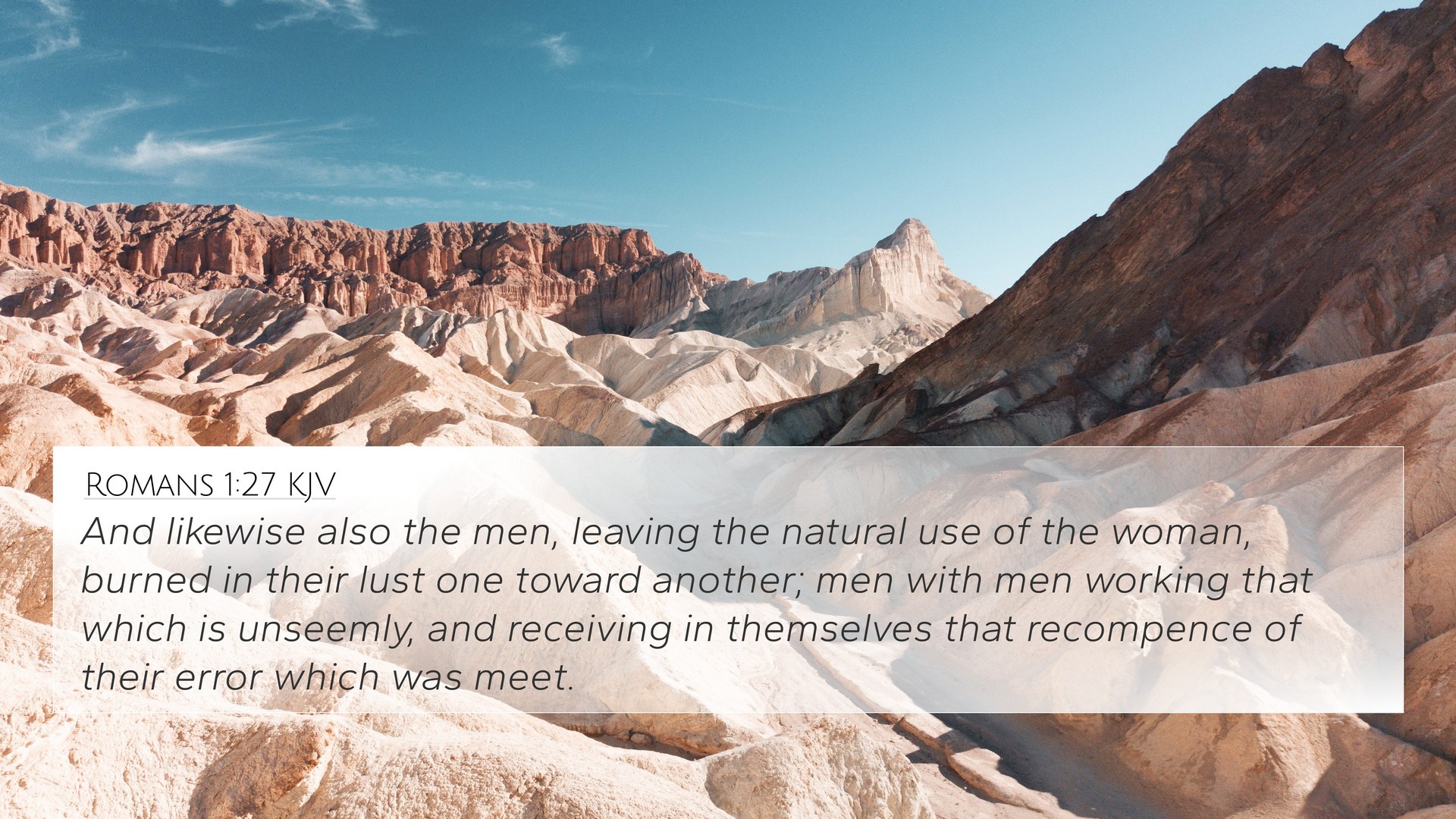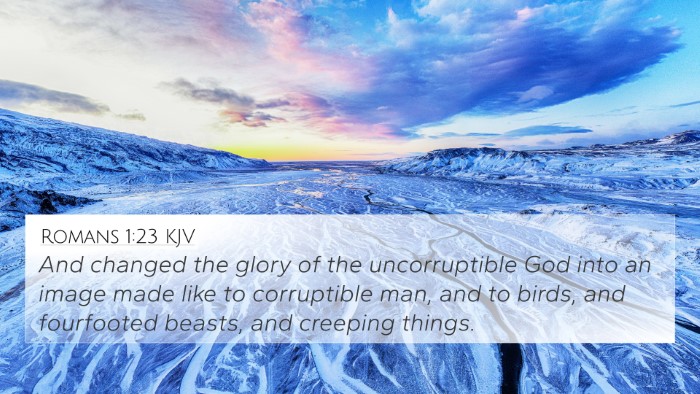Understanding Romans 1:27
Romans 1:27 states: "And likewise also the men, leaving the natural use of the woman, burned in their lust one toward another; men with men working that which is unseemly, and receiving in themselves that recompense of their error which was meet." This verse addresses issues related to human sexuality and moral decay that the Apostle Paul observed in the Roman society of his time.
Overview of Context
The verse is part of Paul's broader teaching in the Book of Romans, where he discusses God's wrath against ungodliness and unrighteousness. Paul argues that humanity has forsaken the knowledge of God and engaged in various forms of moral corruption.
Interpretive Insights
- Matthew Henry: Henry emphasizes the moral implications of abandoning God’s design, suggesting that turning away from God naturally leads to various forms of immorality, including homosexuality. He views this as not just a societal issue but a reflection of inner spiritual turmoil.
- Albert Barnes: Barnes highlights that the "natural use" refers to the intended design of human relationships and procreation. He notes that the behaviors described in this verse were contrary to this divine purpose and suggests divine judgment follows such choices.
- Adam Clarke: Clarke posits that this passage indicates a departure from divine order, and points out the severe consequences that accompany such actions. He also connects the verse to the importance of understanding sexual morality within a biblical context.
Theological Implications
This verse conveys significant theological themes regarding:
- Moral Order: It underscores a belief in an inherent natural order created by God, which humans are to respect.
- Consequences of Sin: There is a strong emphasis on the repercussions of deviating from God's design, signifying that personal choices bear weighty consequences.
- Divine Judgment: The reference to receiving recompense implies God's active role in upholding justice and truth, with moral decay leading to self-inflicted punishment.
Cross-References
To deepen the understanding of Romans 1:27, the following Bible verses serve as cross-references:
- Genesis 19:5: The story of Sodom and Gomorrah, where similar behaviors are condemned, serves as a historical precedent for the moral warnings in Romans.
- Leviticus 18:22: This verse explicitly prohibits male same-sex relations as contrary to God’s commandments.
- 1 Corinthians 6:9-10: Paul includes similar behaviors in a list of sins that will exclude individuals from the kingdom of God, reiterating the severity of moral transgressions.
- 1 Timothy 1:10: This verse categorizes certain immoral behaviors, including those addressed in Romans, as against sound doctrine.
- Sodom and Gomorrah (Jude 1:7): Jude references the cities as a reminder of the judgment that follows sinful practices.
- Galatians 5:19-21: This passage lists the works of the flesh, which includes sexual immorality, linking back to the moral decay Paul points out.
- Ephesians 4:19: Paul describes those who have lost sensitivity to God, engaging in all sorts of impurities, which resonates with his message in Romans.
Comparative Analysis
When conducting a comparative Bible verse analysis, one can see thematic connections between Romans 1:27 and other biblical texts addressing sexual ethics. This highlights:
- The consistent moral teachings throughout both the Old and New Testaments.
- The presence of consequences when turning away from God’s intended purpose for sexuality.
- The prophetic warnings found in the Old Testament serve as a precursor to New Testament teachings on moral integrity.
Thematic Connections
The themes present in Romans 1:27 touch on crucial aspects of:
- Eschatology: The moral degradation relates to end times discussions within biblical prophecy.
- Human Identity: The verse encourages a discussion on how identity is formed and misaligned with God’s creation narrative.
- Redemption: Ultimately, the teachings encourage a call back toward God’s grace as a pathway for restoration and healing.
Tools for Further Study
For those interested in understanding the scripture further, tools for Bible cross-referencing can enhance study:
- Bible Concordance: A valuable resource for finding related verses and themes.
- Cross-reference Bible Study Guides: Guides that help identify links between various scriptural references.
- Comprehensive Bible Cross-reference Materials: Include multiple translations and scholarly interpretations.
- Online Bible Reference Tools: Platforms that allow users to find cross-references quickly.
Final Thoughts
In conclusion, Romans 1:27 serves as a pivotal verse that encapsulates significant moral teaching within the Biblical narrative. Its implications resonate through various scripture connections, encouraging believers to explore the depth and breadth of God's intended design for humanity and sexuality. Through deeper engagement with related verses, readers can gain a holistic understanding of the biblical stance on moral issues.
By utilizing the aforementioned tools and resources, one can cultivate a robust understanding of the Biblical text and its connections, identifying how different passages reflect coherent themes of divine order, morality, and redemption.





